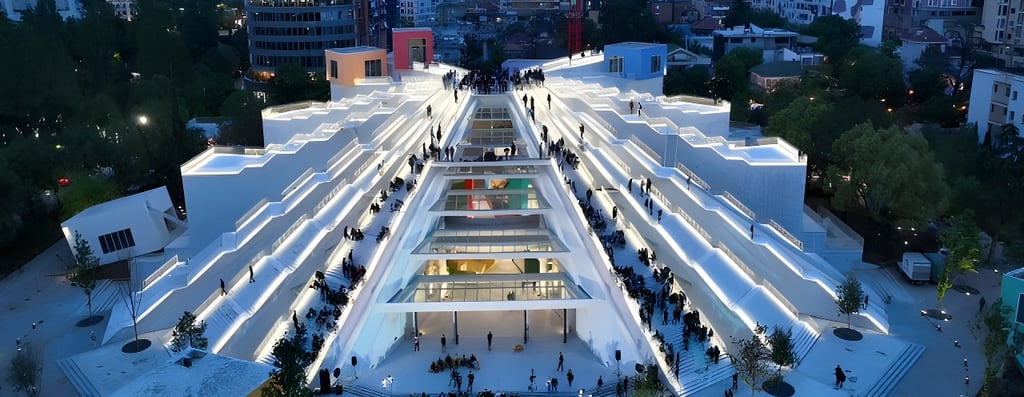The Pyramid of Tirana: From Dictatorship Relic to Cultural Landmark
Discover how Tirana’s iconic Pyramid rose from the ruins of communism to become Albania’s boldest symbol of transformation.


In the heart of Albania’s capital stands one of the most unusual structures in Europe—a concrete pyramid with a complicated past, a rebellious spirit, and a surprisingly bright future. The Pyramid of Tirana, or simply “Piramida” as locals call it, has long sparked debate, awe, confusion, and in recent years, admiration. What began as a monument to Albania’s totalitarian past has evolved into a symbol of transformation—of both a city and a nation.
A Monument to Power
The story of the Pyramid begins in 1988, during the final years of communist rule in Albania. Designed by a team of architects including the daughter and son-in-law of longtime dictator Enver Hoxha, the structure was conceived as a mausoleum to honor Hoxha's legacy after his death in 1985. It was intended to house a museum dedicated to his life and rule, a kind of temple to enshrine the ideology he imposed on the country for over four decades.
At the time, Albania was one of the most isolated countries on earth. The regime had severed ties with the West and even broken away from former allies like the Soviet Union and China. Under Hoxha’s rule, religion was banned, travel forbidden, and surveillance a constant presence. The Pyramid, therefore, was not just a building—it was a symbol of the regime’s self-image: futuristic, absolute, and unchallenged.
The design was radical. Low and wide, with sloping concrete sides and glass panels, it resembled a spaceship more than a mausoleum. Yet its function was clear: to project permanence and power. In stark contrast to the grey, utilitarian buildings around it, the Pyramid looked otherworldly—and in some ways, that was the point.
Fall and Decline
But history had other plans.
Only a few years after the Pyramid was inaugurated, the regime it was built to glorify collapsed. In 1991, Albania’s communist government fell, and with it, the public's tolerance for monuments to its oppression. The Enver Hoxha museum was shut down, and the building’s identity began to unravel.
In the decades that followed, the Pyramid saw a string of reinventions—some more successful than others. It was used as a conference center, a TV station headquarters, and at one point even as a NATO base during the Kosovo War in the late 1990s. But for the most part, it sat unused and crumbling. Teenagers began using the sloping sides to climb and slide down, graffiti artists claimed its walls, and the building became both a playground and a protest, a structure Albanians could reclaim in their own way.
For many residents of Tirana, the Pyramid became a canvas for post-communist expression: anarchic, absurd, ironic. Once a symbol of authoritarian permanence, it had become a monument to the absurdity of power—and its fragility.
A National Debate
What to do with the Pyramid was a question that haunted urban planners and politicians for years.
Some wanted it torn down, calling it an ugly relic of dictatorship. Others argued for its preservation, pointing out its uniqueness and cultural significance. International architects, including Dutch urbanist Winy Maas, advocated for its reinvention, not demolition.
Debates raged. Petitions were signed. Plans were drawn and abandoned. The people of Tirana had a strangely emotional relationship with the Pyramid—many hated what it stood for, but didn’t want to see it disappear. It had become too iconic, too entwined with their own stories.
Reinvention: The Pyramid Reborn
In 2023, after years of uncertainty, the Pyramid reopened—radically transformed.
Thanks to a collaboration between the Albanian government and the TUMO Center for Creative Technologies, the building was repurposed into a youth and technology hub, the first of its kind in the region. The new vision retained the Pyramid’s core shape but stripped away the darkness of its origins, replacing it with bright, open learning spaces for coding, robotics, design, and digital media.
The redesigned Pyramid now functions as a public cultural space, with indoor and outdoor areas that are open to everyone. It includes workshops, classrooms, open stairs, and terraces where visitors can relax, take photos, or simply marvel at the contrast between old and new.
What was once a monument to one man’s ideology is now a living space for the next generation. It's a transformation that speaks volumes about how Tirana—and Albania—are redefining themselves: not by erasing the past, but by confronting it and building something better on top of it.
Architecture with Layers
Architecturally, the Pyramid remains one of Tirana’s most arresting buildings. Even with its new features, the core form—a ziggurat-like structure of sloping concrete and steel—still catches the eye.
The 2023 renovation introduced internal stairs and ramps, making the structure climbable from both inside and out. The once-opaque walls were opened up to natural light. Graffiti, once seen as vandalism, was selectively preserved in parts of the structure, a nod to the way citizens appropriated the building during its wilderness years.
And from the top of the Pyramid? One of the best views of Tirana. You can look out over the city and see its layers—Ottoman domes, Italian facades, communist-era blocks, and glass towers—all coexisting. The Pyramid now joins that visual conversation, no longer out of place but central to it.
A Mirror of Albania
The Pyramid’s journey mirrors Albania’s own path: from isolation to openness, from rigidity to reinvention. It encapsulates the tension between remembering and forgetting, between shame and pride. Albanians do not agree on how to feel about the Pyramid—but perhaps that’s what makes it so important.
It is no longer just a building. It is a story—and now, a space—where memory, creativity, and possibility meet.
Practical Information
Where is it?
The Pyramid is located in central Tirana, on Deshmoret e Kombit Boulevard, near the Prime Minister’s Office and the Lana River. It’s within easy walking distance from Skanderbeg Square and most major hotels.
Opening hours:
The outdoor space is open daily. The interior learning center (TUMO Tirana) has limited access for the general public, as it's designed for enrolled students, but guided tours and public events are occasionally held.
Entrance fee:
Free for the exterior and public areas. Special events or exhibits may charge admission.
For more details on upcoming tech or cultural events visit: https://piramida.edu.al/






